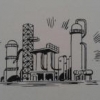Hi !
I have some trouble with a PSV in glycol contactor.
The vendors (fabricators) have a practice to throw in a 1" x 2" PSV with a 'D' orifice on most glycol contactors and say it’s sufficient for the fire case. It may be correct, the PSV may never pop in the next 15 years. Then comes upgrading and modifications to the plant and engineering maybe asked to find out if the PSV is adequate.
What is the latent heat of triethylene glycol which is about 60% pure, 30% water and the 10% C5+ at the relieving conditions? ( Set pressure 80 kg/cm2g). I look for it in Hysys but the mass heat of vaporization results too low. API 521 gives a minimum value of 115 Kj/kg for a HC mixture. Is that correct?
What happens to the contactor in a fire case?
Thank you in advance
Edited by Art Montemayor, 07 June 2014 - 12:42 AM.
Readability, grammar

 FB
FB










